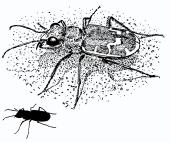
Beetles are the order of insects known as “Coleoptera,” which means “sheath wings.” The underwings are membranous and used for flight, while the outer wings are hard and known as elytra; the latter act as shields to cover and protect the wings and the body while beetles are at rest. Beetles differ from bugs by having a chewing rather than a sucking mouth. They undergo complete metamorphosis, with a soft-bodied larva. There are more species of beetles in the world than any other group in the animal kingdom. Over 2,000 species of beetles of 81 families are known in Saskatchewan, but there are many others still to be found. More species are being added as they are discovered; and others are being added as they are named by scientists doing research work on certain groups.
The province's smallest beetles are some of the feather-winged beetles, and the clambid beetles. They are barely over one-half a millimetre in length. Our largest beetle is a water scavenger beetle, Hydrophilus triangularis, which reaches 39 millimetres in length. Our beetle family with the greatest number of species so far is that of the carabid beetles (Carabidae), which comprises 322 species of ground beetles and tiger beetles. The tiger beetles often have brilliant colours, with paler stripes and markings; they run around on bare earth or sand, and fly so readily that they have to be caught with a net.
Every environment has its own particular kind of beetles. Predacious diving beetles, water scavenger beetles, whirligigs, and crawling water beetles live in the water. Carrion beetles, burying beetles, and some of the hister beetles can be found on dead animals. Dung beetles and some of the hister beetles live in cow dung. Certain species of dung beetles, hister beetles and mammal-nest beetles are found in the burrows and nests of mammals. Various kinds of fungus beetles live on fungi. The larvae of metallic wood-boring beetles and long-horned beetles live in the trunks of dead and dying trees. Bark beetles live under the bark, making peculiar engravings with their tunnels. Leaf beetles feed on leaves, and some of the weevils on fruit. Sap-feeding beetles are found on rotting fruit. The larvae of May beetles feed on the roots of various plants.
Numbers of leaf-eating beetles and weevils are destructive to our crops and gardens. The turnip flea beetle has become a serious pest, attacking garden plants of the mustard family. Some species of cucujid beetles and of darling beetles are destructive to the food stored in cupboards and in granaries. All beetles are not destructive, however: some are decidedly beneficial. Seventy-five species of lady beetles, which feed on aphids that do a lot of damage to plants, are known in Saskatchewan. They are very colourful - most are orange with various arrangements of spots. The seven-spotted lady beetle was introduced to this continent from Europe to help control pests. Since it has reached Saskatchewan it is taking over the native species, many of which are becoming scarcer.
If we pay attention we will find a whole beetle world about us. They are not to be feared: they do not sting, although some can give a sharp pinch. The rove beetles, for instance, have long, bare abdomens which they bring forward over their backs in scorpion-like fashion, but they are only bluffing. Beetles are of great interest, and much can be learned from them and about them.
Ronald R. Hooper